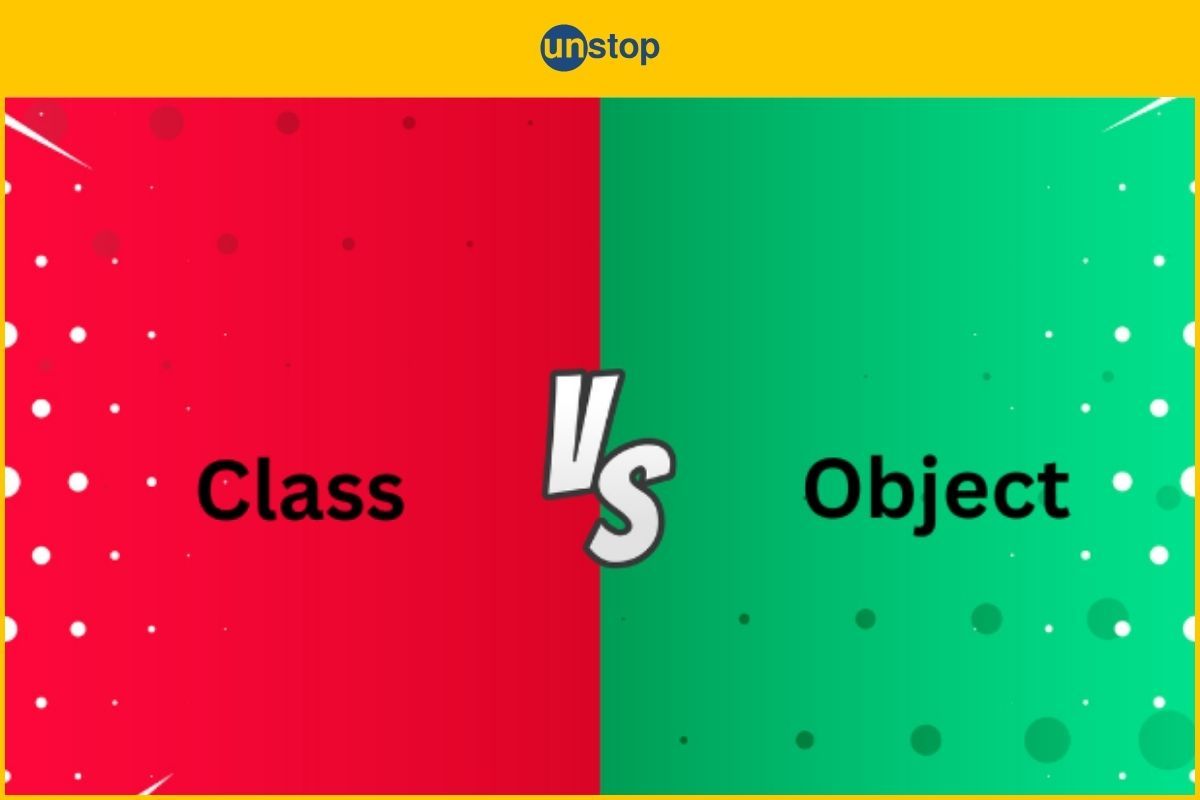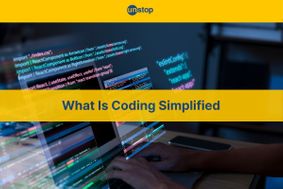- What is Class and Object With Example
- Difference Between Class and Object (Table)
- What is Class and Object in C++ With Example
- What is Class and Object in Python With Example
- Key Difference Between Class and Object Explained with Example
- Importance of Class and Object in Programming
- Conclusion
- Frequently Asked Questions
Difference Between Class And Object Explained In Detail (+Examples)

In the world of object-oriented programming (OOP), understanding the difference between class and object is foundational. Whether you're learning Python, C++, or Java, these two concepts shape how code is structured, reused, and executed. In this guide, we’ll break down what classes and objects really are—with theory, real-world analogies, and code examples—to help you grasp how they differ and why they matter.
What is Class and Object With Example
Before diving into the difference between class and object, let’s understand what they actually are. These are central concepts in object-oriented programming (OOP), which organizes code around real-world entities and behavior.
What is a Class?
A class is a blueprint or template used to create objects. It defines the structure and behavior (via attributes and methods) that its objects will have—but it does not occupy memory itself.
Key Characteristics:
- It defines what an object will be.
- It contains variables (attributes) and functions (methods).
- It’s a logical structure, not a real entity until instantiated.
What is an Object?
An object is an actual instance of a class. Once a class is defined, you can create multiple objects from it. Each object holds its own copy of the class’s properties and can invoke its methods.
Key Characteristics:
- It is the actual entity that occupies memory.
- You can create many objects from a single class.
- Objects can have different values for their attributes.
Real-World Analogy of Class and Object in OOPs
Think of a class as the blueprint for a car. It defines things like how many wheels it has, where the engine goes, and what controls are available. But no actual car exists yet.
An object is the real car you build from that blueprint. You can build many cars (objects) from one design (class), each possibly painted a different color or with different features.
Code Example (Python):
# Defining a class
class Car:
def __init__(self, brand, model):
self.brand = brand
self.model = model
def drive(self):
print(f"{self.brand} {self.model} is driving.")
# Creating an object from the class
my_car = Car("Toyota", "Camry")
my_car.drive()
IyBEZWZpbmluZyBhIGNsYXNzCmNsYXNzIENhcjoKICAgIGRlZiBfX2luaXRfXyhzZWxmLCBicmFuZCwgbW9kZWwpOgogICAgICAgIHNlbGYuYnJhbmQgPSBicmFuZAogICAgICAgIHNlbGYubW9kZWwgPSBtb2RlbAogICAgZGVmIGRyaXZlKHNlbGYpOgogICAgICAgIHByaW50KGYie3NlbGYuYnJhbmR9IHtzZWxmLm1vZGVsfSBpcyBkcml2aW5nLiIpCiMgQ3JlYXRpbmcgYW4gb2JqZWN0IGZyb20gdGhlIGNsYXNzCm15X2NhciA9IENhcigiVG95b3RhIiwgIkNhbXJ5IikKbXlfY2FyLmRyaXZlKCkK
Output:
Toyota Camry is driving.
Explanation:
Here, Car is the class and my_car is the object (an instance of the class). Then, brand and model are object-specific attributes and drive() is a method defined in the class and used by the object.
In the following sections, we’ll explore how classes and objects work in C++ and Python, and then dive deeper into the difference between class and object with detailed comparisons and examples.
Difference Between Class and Object (Table)
Now that you understand what classes and objects are let’s look at the key differences between them. While they’re closely related—one cannot exist without the other—they serve very different roles in object-oriented programming.
A class is abstract—it defines what something should be. An object is concrete—it is the actual thing built using that definition. The table below highlights the difference between class and object.
Class vs. Object: A Comparison
|
Parameter |
Class |
Object |
|
Definition |
Blueprint or template for creating objects |
Real-world instance created from a class |
|
Existence |
Logical entity, does not occupy memory on its own |
Physical entity, occupies memory when created |
|
Creation |
Defined only once |
Multiple objects can be created from a single class |
|
Memory Allocation |
No memory is allocated at the definition |
Memory is allocated when an object is instantiated |
|
Use in Code |
Used to group related data and behavior |
Used to access class features and store real values |
|
Data Containment |
Only defines the structure (attributes & methods) |
Contains actual data in those attributes |
|
Reusability |
Encourages reusability by defining a common structure |
Allows diverse instances with shared structure but unique values |
|
Example in Real Life |
A car blueprint or recipe |
A specific car you drive or a dish you cook |
|
Keyword Used (Python) |
class |
Created using the class constructor (e.g., my_car = Car()) |
|
Keyword Used (C++) |
class |
Objects declared using the class type (e.g., Car myCar;) |
|
Lifespan in Memory |
Exists throughout the code as a definition |
Lives only as long as it’s referenced or not deleted |
|
Accessibility |
Cannot directly access attributes or methods without instantiation |
Can access methods and properties using dot notation |
|
Modification |
The structure is fixed once defined |
Object attributes can be modified during runtime |
|
Dependency |
Can exist without any objects |
Cannot exist without a class |
TL;DR:
- You define a class, but you use an object.
- A class is like a plan; the object is the working product.
- Classes are static; objects are dynamic.
In the next section, we’ll walk through how to create and use classes and objects in C++, including syntax and examples. Let’s dive into it.
What is Class and Object in C++ With Example
In C++, classes and objects are the building blocks of object-oriented programming. A class defines the blueprint—the properties (variables) and behaviors (methods/member functions) that its objects will have. An object, on the other hand, is a real instance of that class created during program execution. Let’s break this down with proper syntax, explanation, and a real example.
Defining Class and Object in C++
To define a class and create objects in C++, you use the class keyword followed by access specifiers, variables, and functions. Once the class is defined, you can create objects from it using the class name. Here’s a basic structure:
class ClassName {
public: // Access specifier
// Data members (attributes)
// Member functions (methods)
};// Object creation
ClassName objectName;
Explanation of Syntax:
- class ClassName – Declares a class with the name ClassName.
- public: – Access specifier that makes members accessible from outside the class.
- Inside the class:
- Data members (like string name;) hold information.
- Member functions (like void show();) define behavior.
- ClassName objectName; – This line creates an object from the class.
A class can contain multiple variables and methods, and you can create multiple objects from it, each holding different data but sharing the same structure.
Example of Class and Object in C++
#include
using namespace std;
class Student {
public:
string name;
int age;
void introduce() {
cout << "Hi, I'm " << name << " and I'm " << age << " years old." << endl;
}
};
int main() {
Student s1; // Object creation
s1.name = "Riya";
s1.age = 21;
s1.introduce(); // Method call
return 0;
}
I2luY2x1ZGUgPGlvc3RyZWFtPgp1c2luZyBuYW1lc3BhY2Ugc3RkOwpjbGFzcyBTdHVkZW50IHsKICBwdWJsaWM6CiAgICBzdHJpbmcgbmFtZTsKICAgIGludCBhZ2U7CiAgICB2b2lkIGludHJvZHVjZSgpIHsKICAgICAgY291dCA8PCAiSGksIEknbSAiIDw8IG5hbWUgPDwgIiBhbmQgSSdtICIgPDwgYWdlIDw8ICIgeWVhcnMgb2xkLiIgPDwgZW5kbDsKICAgIH0KfTsKaW50IG1haW4oKSB7CiAgU3R1ZGVudCBzMTsgICAgICAgICAgICAgICAgICAvLyBPYmplY3QgY3JlYXRpb24KICBzMS5uYW1lID0gIlJpeWEiOwogIHMxLmFnZSA9IDIxOwogIHMxLmludHJvZHVjZSgpOyAgICAgICAgICAgICAgLy8gTWV0aG9kIGNhbGwKICByZXR1cm4gMDsKfQ==
Output:
Hi, I'm Riya and I'm 21 years old.
This example shows how the class acts as a template, while the object (s1) holds actual values and can perform operations using methods.
Want to explore this in more depth, including constructors, private members, and more?
Check out our complete guide: C++ Classes and Objects Explained
What is Class and Object in Python With Example
Python is an object-oriented language at its core, and understanding classes and objects is key to writing efficient and scalable code. A class in Python defines a data structure and behavior, while an object is an actual instance of that class with real data. Let’s look at how Python uses these concepts in practice.
Defining Class and Object in Python
In Python, you use the keyword class to define a class, and the constructor method __init__() to initialize object-specific data. Objects are then created by calling the class like a function. Here’s the basic syntax:
class ClassName:
def __init__(self, parameters):
# data members (attributes)
def method_name(self):
# behavior or actions# Object creation
object_name = ClassName(arguments)
Explanation of Syntax:
- class ClassName: – Declares a new class.
- __init__() – The constructor method that gets called when a new object is created.
- self – Refers to the current object instance; it's required in all class methods.
- Attributes – Defined inside __init__() and assigned to self.
- Methods – Define what actions the object can perform.
- object_name = ClassName() – Instantiates an object of the class.
In Python, everything is an object—even classes themselves—so object-oriented design is deeply integrated into the language.
Example of Class and Object in Python
class Student:
def __init__(self, name, age):
self.name = name
self.age = age
def introduce(self):
print(f"Hi, I'm {self.name} and I'm {self.age} years old.")
# Creating an object
s1 = Student("Riya", 21)
s1.introduce()
Y2xhc3MgU3R1ZGVudDoKICAgIGRlZiBfX2luaXRfXyhzZWxmLCBuYW1lLCBhZ2UpOgogICAgICAgIHNlbGYubmFtZSA9IG5hbWUKICAgICAgICBzZWxmLmFnZSA9IGFnZQogICAgZGVmIGludHJvZHVjZShzZWxmKToKICAgICAgICBwcmludChmIkhpLCBJJ20ge3NlbGYubmFtZX0gYW5kIEknbSB7c2VsZi5hZ2V9IHllYXJzIG9sZC4iKQojIENyZWF0aW5nIGFuIG9iamVjdApzMSA9IFN0dWRlbnQoIlJpeWEiLCAyMSkKczEuaW50cm9kdWNlKCk=
Output:
Hi, I'm Riya and I'm 21 years old.
Explanation:
In this example:
- Student is the class.
- s1 is the object created from it.
- The object stores actual data (name, age) and can call methods like introduce().
Want to go beyond the basics? Learn about class inheritance, class variables, and more in our detailed guide: Python Classes and Objects Explained
Key Difference Between Class and Object Explained with Example
Earlier, we looked at a quick comparison of classes and objects in tabular form. Now, let’s go deeper and explain the most important differences between them—so you not only memorize the terms but also truly understand the “why” behind them.
1. Conceptual Difference: Class vs. Object
- Class: Think of a class as a plan or design. It’s abstract—it outlines what an object should be like but doesn’t represent anything real on its own.
- Object: This is the actual thing built from the design. It's a concrete instance that exists in memory and can perform tasks using the structure the class provides.
Example: A class is like the idea of a "smartphone," while an object is the iPhone 14 or Samsung Galaxy you actually own.
2. Memory Allocation: Class vs. Object
- Class: No memory is allocated when a class is defined—only when an object is created.
- Object: Memory is allocated when an object is instantiated, and it stores real data (like values in variables).
Implication: You can define hundreds of classes in a program, but memory usage only grows when objects are created from them.
3. Usage in Code: Class vs. Object
- Class: Used to organize related variables and functions in one structure. It gives your program modularity and reusability.
- Object: Used to store real values and call functions defined in the class. Without creating an object, you can’t use most class features.
Example in Python:
class Car:
def drive(self):
print("Driving...")
# You must create an object to use the class:
my_car = Car()
my_car.drive()
4. Data and Behavior: Class vs. Object
- Class: Defines what data an object can have (e.g., name, age) and what it can do (e.g., introduce() method).
- Object: Actually holds the data and performs the behavior.
Analogy: A class says a bird can fly and chirp. An object is the sparrow that’s actually flying and chirping.
5. Multiplicity: Class vs. Object
- Class: Defined once.
- Object: You can create as many objects as you want from a single class, each with different attribute values.
Example: One Student class, but 100 different student objects—each with their own name and age.
6. Modifiability: Class vs. Object
- Class: The class structure is static once defined, unless edited in the codebase.
- Object: Object attributes can be changed at runtime without altering the class itself.
Implication: You can change a user’s name or age (object data), but not the fact that all users must have a name and age (class structure).
Importance of Class and Object in Programming
Classes and objects are not just theoretical concepts—they form the backbone of object-oriented programming (OOP). They help developers write modular, reusable, and maintainable code across languages like C++, Python, Java, and more. Here’s why they matter:
- Structure & Organization: Classes let you logically group related data and behavior into one entity—making your code more readable and organized.
- Reusability: You define a class once and reuse it to create as many objects as you want. This prevents code duplication and reduces effort.
- Encapsulation: Objects can hide their internal state and expose only what’s necessary. This protects data from unintended changes.
- Scalability: As your application grows, using objects makes it easier to scale functionality without rewriting existing code.
- Real-world Modelling: OOP lets you model real-world entities (like users, products, vehicles) in a natural and intuitive way.
- Debugging & Maintenance: When functionality is split across objects, you can identify bugs and fix them without impacting unrelated parts of the program.
In short, classes define possibilities, and objects make them happen. Together, they make programming not only more efficient but also more aligned with how we think about systems in the real world.
Conclusion
At its core, the difference between class and object lies in abstraction versus implementation. A class defines the structure and capabilities—it's the idea. An object, on the other hand, is the real entity built from that idea, capable of storing values and performing actions.
In programming, this distinction enables cleaner architecture, reusable components, and better modeling of real-world problems. Once you internalize the difference between class and object, you'll not only write more efficient code, but also think more clearly about how to structure and scale your programs.
Frequently Asked Questions
Q1. What is the main difference between class and object?
A class is a blueprint or template that defines variables and methods. An object is an actual instance of a class that holds data and can perform actions defined by the class.
Q2. Is a class a datatype?
Yes, in many programming languages (like C++ and Java), a class is considered a user-defined data type. It groups variables and functions under one structure.
Q3. Can we have multiple objects of the same class?
Absolutely. You can create multiple objects from a single class, each with its own unique data. This allows reusability and memory-efficient code.
Q4. Are class and object only used in OOP languages?
Primarily, yes. Classes and objects are core to object-oriented programming (OOP), but some non-OOP languages can simulate object behavior using other constructs.
Q5. Do all objects of a class share the same values?
No. Each object of a class has its own copy of instance variables, so values can differ from one object to another. However, they share the same methods and class-level behavior.
Q6. Can a class exist without an object?
Yes, a class can exist without any object being created. But until an object is instantiated, the class itself doesn’t hold or perform any action—it remains just a definition.
Q7. Which comes first: class or object?
Always the class. You define the class first, then create objects from it. Without a class, there’s no structure for the object to be based on.
Q8. How are classes and objects stored in memory?
- Class definitions are stored in the code segment and don’t consume instance-level memory.
- Objects are stored in the heap (in most languages), and each object gets its own memory space for instance variables.
By now you must know all about the difference between class and object. Here are a few more topics you must explore:
An economics graduate with a passion for storytelling, I thrive on crafting content that blends creativity with technical insight. At Unstop, I create in-depth, SEO-driven content that simplifies complex tech topics and covers a wide array of subjects, all designed to inform, engage, and inspire our readers. My goal is to empower others to truly #BeUnstoppable through content that resonates. When I’m not writing, you’ll find me immersed in art, food, or lost in a good book—constantly drawing inspiration from the world around me.
Login to continue reading
And access exclusive content, personalized recommendations, and career-boosting opportunities.
Subscribe
to our newsletter
















Comments
Add comment